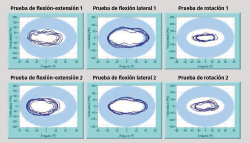Resumen
Introducción: el “latigazo cervical” consiste en la lesión producida por una sucesiva flexión y extensión brusca y excesiva del cuello. La causa más común es un accidente de coche en el que se produce un impacto por detrás, de manera que la musculatura está relajada y no frena ni limita el rango de movimiento.
Objetivo: valorar con técnica biomecánica la repercusión funcional de una paciente, mediante variables objetivas, para conocer su estado actual, ayudando a la toma de decisiones clínicas.
Materiales y métodos: caso clínico de una paciente con latigazo cervical. Se le realiza prueba de valoración funcional biomecánica del raquis cervical basada en análisis cinemático del movimiento (NedCervical/IBV).
Resultados: la primera valoración biomecánica muestra alteración de la movilidad cervical. Ante estos resultados y persistencia de dolor, se realiza nueva prueba biomecánica a los 2 meses, siendo en este caso el resultado de movilidad funcional normal.
Conclusión: la técnica biomecánica ha resultado una herramienta útil, como prueba complementaria, para la valoración funcional y para control evolutivo de la paciente con latigazo cervical, coadyuvando a su reincorporación laboral.
Abstract
Introduction: the “whiplash” consists of the injury produced by a successive bending and abrupt and excessive extension of the neck. The most common cause is a car accident in which there is an impact from behind, so that the musculature is relaxed and does not slow down or limit the range of movement.
Objective: to evaluate with biomechanical technique the functional repercussion of a patient, by means of objective variables to know their current state, helping the clinical decision making.
Materials and methods: clinical case of a whiplash patient who underwent functional biomechanical assessment of the cervical spine based on motion kinematic analysis (NedCervical / IBV).
Results: the first biomechanical assessment of the cervical spine shows alteration of cervical mobility. In view of these results and the persistence of pain, a new biomechanical test is performed at 2 months, in this case being the result of normal functional mobility.
Conclusion: the biomechanical technique has turned out to be a useful tool, as a complementary test, for the functional assessment and for the evolutionary control of the whiplash patient, contributing to their labor reincorporation.
Artículo
Figuras y tablas
Referencias
Descargas
Licencia
Este contenido es de acceso abierto (Open-Access) y se ha distribuido bajo los términos de la licencia Creative Commons CC BY-NC-ND (Reconocimiento-NoComercial-SinObraDerivada 4.0 Internacional) que permite usar, distribuir y reproducir en cualquier medio siempre que se citen a los autores y no se utilice para fines comerciales ni para hacer obras derivadas.



